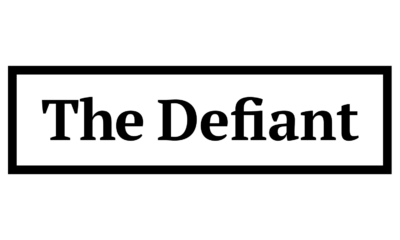DeFi
Unveiling The Players Of 2024

June 6, 2024 by Diana Ambolis
42
The institutional crypto lending market is a dynamic landscape with a growing number of players vying for a piece of the pie. Let’s delve into the key players, analyze their offerings, and explore the evolving competitive landscape. Institutional Crypto Lending Platforms: Unveiling the Players of 2024 As the cryptocurrency market matures and institutional adoption gathers
The institutional crypto lending market is a dynamic landscape with a growing number of players vying for a piece of the pie. Let’s delve into the key players, analyze their offerings, and explore the evolving competitive landscape.
Institutional Crypto Lending Platforms: Unveiling the Players of 2024
As the cryptocurrency market matures and institutional adoption gathers pace, the demand for secure and reliable crypto lending platforms tailored for sophisticated investors is skyrocketing. In 2024, a vibrant landscape of institutional crypto lending platforms is poised to shape the future of digital asset financing. Here, we delve into the key players, their unique offerings, and the evolving dynamics of this dynamic market:
The Established Players: A Legacy of Trust and Security
- Bakkt (Intercontinental Exchange): Leveraging the heritage and trust of the Intercontinental Exchange (ICE), Bakkt offers a regulated and institutional-grade platform for crypto custody, trading, and lending. Catering to large institutions and accredited investors, Bakkt prioritizes security, compliance, and seamless integration with existing financial infrastructure.
- Fidelity Digital Assets: A subsidiary of the financial services giant Fidelity Investments, Fidelity Digital Assets provides a comprehensive suite of crypto custody, trading, and lending solutions for institutional clients. Their focus on institutional-grade security, regulatory compliance, and deep industry expertise positions them as a trusted partner for large investors entering the crypto space.
- State Street Digital: State Street, a leading global custodian bank, has established State Street Digital, a dedicated platform offering secure custody, trading, and financing solutions for digital assets. Leveraging their established relationships with institutional investors and robust risk management practices, State Street Digital fosters trust and facilitates the entry of traditional finance players into the crypto lending market.
The Rising Stars: Innovation and Niche Expertise
- BlockFi: A pioneer in the retail crypto lending space, BlockFi is expanding its offerings to cater to institutional investors. BlockFi emphasizes high-yield interest accounts on deposited crypto assets, catering to institutions seeking attractive returns on their digital holdings. Their user-friendly platform and focus on transparency are attracting a growing base of institutional clients.
- Celsius Network: Another player transitioning from retail to institutional crypto lending, Celsius Network boasts a unique model that rewards users with its native CEL token for holding assets on their platform. This value proposition, coupled with competitive interest rates, is attracting institutions seeking a combination of yield and potential token appreciation.
- Genesis (Digital Currency Group): A subsidiary of Digital Currency Group, Genesis is a prominent institutional crypto prime brokerage offering a wide range of services, including lending, over-the-counter (OTC) trading, and asset management. Their focus on deep liquidity, customized solutions, and strong credit risk management caters to the specific needs of hedge funds, asset managers, and other sophisticated investors.
The Decentralized Disruptors: DeFi Lending Protocols
- Compound: A leading decentralized finance (DeFi) protocol, Compound allows institutions to lend and borrow crypto assets in a permissionless and transparent manner. Leveraging smart contracts and automated liquidity pools, Compound offers competitive interest rates and eliminates the need for intermediaries, potentially disrupting traditional lending models.
- Aave: Another prominent DeFi lending protocol, Aave provides a flexible platform where institutions can lend and borrow a wider range of crypto assets compared to centralized platforms. Its focus on community governance and innovative features like flash loans is attracting institutions seeking a more dynamic and customizable lending experience.
- MakerDAO: The pioneer of decentralized stablecoin lending, MakerDAO allows institutions to mint DAI, a decentralized stablecoin pegged to the US dollar, by depositing crypto assets as collateral. This innovative model offers a unique way for institutions to access USD liquidity without relying on traditional financial channels.
The Evolving Landscape: Key Considerations for Institutional Investors
- Regulation and Compliance: Regulatory uncertainty and evolving compliance requirements remain key considerations for institutional investors. Platforms with robust compliance frameworks, clear risk management practices, and a commitment to regulatory adherence will be well-positioned to attract institutional capital.
- Security and Custody: The security of digital assets is paramount for institutional investors. Platforms with a proven track record of secure custody solutions, robust insurance policies, and rigorous penetration testing will be favored by risk-averse institutions.
- Liquidity and Counterparty Risk: Institutional investors require deep liquidity pools to ensure efficient execution of large-scale lending and borrowing transactions. Platforms with strong partnerships with other institutions and robust risk management practices will mitigate counterparty risk and ensure the timely settlement of transactions.
- Yield and Risk Management: Maximizing returns while managing risk is crucial for institutional investors. Platforms offering competitive interest rates, flexible lending options, and sophisticated risk management tools will attract institutions seeking optimal returns on their crypto investments.
Collaborative Future for Institutional Crypto Lending
The institutional crypto lending market in 2024 promises to be a dynamic space characterized by collaboration and competition. Established players with a legacy of trust and security will vie for market share with innovative DeFi protocols offering decentralized lending solutions. Ultimately, institutional investors will benefit from a diverse range of platforms
The Competitive Landscape: New Entrants and Strategic Alliances
The institutional crypto lending space is attracting new entrants, further intensifying the competition and fostering innovation. Here, we explore the influx of new players and the strategic alliances being forged in this dynamic market:
New Entrants: Disrupting the Status Quo
- Traditional Financial Institutions: Major investment banks, commercial banks, and asset management firms are actively exploring the launch of their own institutional crypto lending platforms. Their established infrastructure, regulatory expertise, and existing client relationships position them as potential game-changers in the market. However, overcoming internal resistance to crypto adoption and navigating complex regulatory hurdles remain challenges they need to address.
- Crypto-Native Custodians: Existing crypto custody providers are expanding their offerings to encompass lending services. Their deep understanding of the crypto ecosystem, secure custody solutions, and established client base in the crypto space give them a significant competitive edge. However, they may need to bolster their experience in traditional finance and risk management to cater effectively to the needs of institutional investors.
- FinTech Startups: Agile and innovative FinTech startups are emerging with specialized crypto lending platforms targeting specific niches within the institutional investor landscape. Their focus on cutting-edge technology, user-friendly interfaces, and niche expertise allows them to cater to specific investor needs. However, building trust and brand recognition in a crowded market and competing with established players for market share are key challenges they face.
Strategic Alliances: A Collaborative Approach to Growth
- Legacy Finance and Crypto Expertise: Established financial institutions are forging strategic partnerships with crypto-native platforms to leverage their expertise in crypto custody, lending protocols, and market insights. These collaborations bridge the gap between traditional finance and the crypto ecosystem, fostering innovation and accelerating institutional adoption of crypto lending services.
- DeFi Integration with TradFi Infrastructure: DeFi lending protocols are exploring partnerships with traditional financial institutions to leverage their established infrastructure and regulatory expertise. This integration could allow DeFi protocols to offer their competitive interest rates and seamless lending experience to a wider range of institutional investors, while traditional institutions gain exposure to the innovative potential of DeFi.
- Consortium Models for Risk Mitigation: Collaboration among multiple institutions to create consortium-based lending platforms is a nascent trend. By sharing the risks and rewards associated with crypto lending, these consortiums can mitigate counterparty risk and attract a broader pool of institutional investors seeking a more diversified approach to crypto exposure.
The Impact of New Entrants and Alliances
The influx of new entrants and the formation of strategic alliances will significantly impact the institutional crypto lending landscape in several ways:
- Increased Competition and Innovation: The entry of new players will intensify competition, leading to more competitive interest rates, innovative lending products, and a wider range of services tailored to meet the specific needs of various institutional investors.
- Enhanced Security and Regulatory Compliance: New entrants with established expertise in traditional finance can contribute to enhanced security protocols and robust compliance frameworks within the crypto lending space. This will foster trust and confidence among institutional investors with stringent risk management requirements.
- Improved Liquidity and Market Efficiency: The combined efforts of established players and new entrants will contribute to deeper liquidity pools within the institutional crypto lending market. This ensures efficient execution of large-scale transactions and fosters greater market stability.
- Democratization of Crypto Lending: Strategic alliances between DeFi protocols and traditional financial institutions can potentially democratize access to crypto lending services. A wider range of institutional investors, from large hedge funds to smaller asset managers, will gain access to this innovative financing tool.
A Thriving Ecosystem for the Future
The institutional crypto lending space is poised for significant growth and transformation. The influx of new entrants, coupled with the formation of strategic alliances, will create a thriving ecosystem characterized by fierce competition, continuous innovation, and a focus on security, compliance, and risk management. As this market matures, institutional investors will benefit from a diverse range of lending platforms, sophisticated products, and competitive interest rates, ultimately unlocking the full potential of crypto lending in the financial landscape.
The Future Unfolds: A Maturing Market
The competitive landscape for institutional crypto lending is likely to become increasingly crowded. As the market matures, we can expect to see several key trends emerge:
- Regulation and Standardization: Regulatory clarity and the establishment of standardized practices will be crucial for fostering long-term institutional adoption. Governments and industry bodies are likely to collaborate on developing clear regulatory frameworks that address issues like anti-money laundering (AML) and Know Your Customer (KYC) compliance, while promoting innovation and mitigating systemic risks.
- Focus on User Experience and Automation: Platforms will prioritize user experience by offering intuitive interfaces, streamlined onboarding processes, and advanced analytics tools. Automation of key tasks, such as collateral management and risk assessment, will become increasingly prevalent, improving efficiency and reducing operational costs for both lenders and borrowers.
- Integration with Traditional Finance: Seamless integration with existing financial infrastructure will be essential for widespread institutional adoption. This may involve the development of standardized messaging protocols, interoperability between traditional and crypto lending platforms, and the creation of regulated crypto custody solutions.
- The Rise of Tokenization: The tokenization of traditional assets like real estate, debt, and private equity is expected to unlock new opportunities for institutional crypto lending. Tokenized assets can be easily fractionated and traded on secondary markets, facilitating greater liquidity and attracting a broader range of institutional investors.
- Convergence of DeFi and CeFi: A potential convergence of Decentralized Finance (DeFi) and Centralized Finance (CeFi) could emerge. DeFi lending protocols may integrate features like regulatory compliance and KYC procedures to attract institutional investors, while CeFi platforms may incorporate elements of DeFi, such as permissionless lending and automated market makers, to offer more competitive rates and innovative products.
The Evolving Role of Institutional Investors
As the institutional crypto lending market matures, we can expect to see a shift in the role of institutional investors:
- From Early Adopters to Market Makers: Early adopters who entered the market for speculative purposes may transition to a more strategic role, acting as market makers by providing liquidity and facilitating efficient price discovery within the crypto lending ecosystem.
- Increased Demand for Diversification and Yield Enhancement: Institutional investors will continue to seek out crypto lending as a means to diversify their portfolios and generate attractive returns in a low-interest-rate environment. Platforms offering a wider range of crypto assets, innovative lending products, and sophisticated risk management tools will be well-positioned to cater to these demands.
- Active Participation in Governance: Institutional investors with a vested interest in the long-term sustainability of the market may become more actively involved in the governance of DeFi lending protocols. This could involve shaping protocol parameters, proposing upgrades, and contributing to the overall health and security of the DeFi ecosystem.
A Bright Future for Institutional Crypto Lending
The future of institutional crypto lending is undeniably bright. As the market matures, regulations evolve, and technology advances, we can expect to see a vibrant ecosystem emerge, characterized by fierce competition, innovation, and a focus on security, compliance, and risk management. This will ultimately unlock the full potential of crypto lending, transforming the way institutional investors access liquidity, manage their crypto holdings, and participate in the burgeoning digital asset economy. By staying informed about the evolving landscape and adapting their strategies accordingly, institutional investors can seize the vast opportunities presented by this transformative financial instrument.
Also, read – Staking vs. Lending Crypto: Top 10 Amazing Ways to Maximize Your Returns In A Bear Market
Conclusion: A Buyer’s Market for Institutions
The expanding pool of institutional crypto lending platforms offers a buyer’s market for institutions. By carefully comparing loan terms, interest rates, security features, and the overall client experience, institutions can select a platform that best aligns with their specific needs and risk tolerance. As the market matures and competition intensifies, innovation, security, and exceptional client service will be the key drivers of success for institutional crypto lending platforms.
DeFi
Haust Network Partners with Gateway to Connect to AggLayer

Dubai, United Arab Emirates, August 1, 2024, Chainwire
Consumer adoption of cryptocurrencies is a snowball that is accelerating by the day. More and more people around the world are clamoring for access to DeFi. However, the user interface and user experience of cryptocurrencies still lag behind their fundamental utility, and users lack the simple and secure access they need to truly on-chain products.
Haust Network is a network and suite of products focused on changing this paradigm and bringing DeFi to the masses. To achieve this goal, Haust Network has announced its far-reaching partnership with bridgeseasoned veterans in rapidly delivering revolutionary blockchain utilities for projects. The Gateway team empowers blockchain developers to build DAOs, NFT platforms, payment services, and more. They drive adoption of crypto primitives for individuals and institutions around the world by helping everyone build their on-chain presence.
Gateway specializes in connecting sovereign blockchains to the Aggregation Layer (AggLayer). The AggLayer is a single unified contract that powers the Ethereum bridge of many disparate blockchains, allowing them all to connect to a single unified liquidity pool. The AggLayer abstracts away the complexities of cross-chain DeFi, making tedious multi-chain transactions as easy for the end user as a single click. It’s all about creating access to DeFi, and with Polygon’s technology and the help of Gateways, Haust is doing just that.
As part of their partnership, Gateway will build an advanced zkEVM blockchain for Haust Network, leveraging its extensive experience to deploy ultra-fast sovereign applications with unmatched security, and enabling Haust Network to deliver its products to its audience.
The recently announced launch of the Haust Wallet is a Telegram mini-app that provides users with access to DeFi directly through the Telegram interface. Users who deposit funds into the wallet will have access to all standard send/receive services and generate an automatic yield on their funds. The yield is generated by Haust Network’s interconnected network of smart contracts, Haustoria, which provides automated and passive DeFi yielding.
As part of this partnership, the Haust Network development team will work closely with Gateway developers to launch Haust Network. Gateway is an implementation provider for Polygon CDK and zkEVM technology, which the Haust wallet will leverage to deliver advanced DeFi tools directly to the wallet users’ fingertips. Haust’s partnership with Gateway comes shortly after the announcement of a high-profile alliance with the Polygon community. Together, the three will work to build Haust Network and connect its products to the AggLayer.
About Haust Network
Haust Network is an application-based absolute liquidity network and will be built to be compatible with the Ethereum Virtual Machine (EVM). Haust aims to provide native yield to all users’ assets. In Telegram’s Haust Wallet, users can spend and collect their cryptocurrencies in one easy place, at the same time. Haust operates its network of self-balancing smart contracts that interact across multiple blockchains and then efficiently funnel what has been generated to Haust users.
About Gateway
bridge is a leading white-label blockchain provider that offers no-code protocol deployment. Users can launch custom blockchains in just ten minutes. They are an implementation provider for Polygon CDK and have already helped projects like Wirex, Gnosis Pay, and PalmNFT bring new utility to the crypto landscape.
About Polygon Labs
Polygon Laboratories Polygon Labs is a software development company building and developing a network of aggregated blockchains via the AggLayer, secured by Ethereum. As a public infrastructure, the AggLayer will aggregate the user bases and liquidity of any connected chain, and leverage Ethereum as the settlement layer. Polygon Labs has also contributed to the core development of several widely adopted scaling protocols and tools for launching blockchains, including Polygon PoS, Polygon zkEVM, and Polygon Miden, which is currently under development, as well as the Polygon CDK.
Contact
Lana Kovalski
haustnetwork@gmail.com
DeFi
Ethena downplays danger of letting traders use USDe to back risky bets – DL News

- Ethena and ByBit will allow derivatives traders to use USDe as collateral.
- There is a risk in letting traders use an asset partially backed by derivatives to place more bets.
Ethena has downplayed the dangers of a new feature, which will allow traders to put up its synthetic dollar USDe as collateral when trading derivatives, which are risky bets on the prices of crypto assets.
While allowing users to underwrite their trades with yield-bearing USDe is an attractive prospect, Ethena said there is potential risk in letting traders use an asset partially backed by derivatives to place even more derivatives bets.
“We have taken this risk into account and that is why Ethena operates across more than five different sites,” said Conor Ryder, head of research at Ethena Labs. DL News.
The move comes as competition in the stablecoin sector intensifies.
In recent weeks, PayPal grown up the amount of its stablecoin PYUSD in circulation 96%, while the MakerDAO cooperative plans a rebrandingaiming to increase the supply of its DAI stablecoin to 100 billion.
US dollar growth stagnates
It comes as Ethena has lost momentum after its blockbuster launch in December.
In early July, USDe reached a record level of 3.6 billion in circulation.
That figure has now fallen by 11% to around 3.2 billion.
Join the community to receive our latest stories and updates
New uses for USDe could boost demand for Ethena’s products.
This is where the new plan, announcement Tuesday with ByBit, one of its partner exchanges, is coming.
Ethena users create USDe by depositing Bitcoin or Ether into the protocol.
Ethena then covers these deposits with short positions – bearish bets – on the corresponding asset.
This creates a stable support for USDe, unaffected by price fluctuations in Bitcoin or Ether.
Mitigate risks
While using USDe as collateral for derivatives trading is proving popular, it is unclear what the effects will be if the cryptocurrency market experiences major fluctuations.
Using derivatives as collateral to place more bets has already had disastrous effects.
In June 2022, Lido’s liquid staking token stETH broke its peg to Ether following the fallout from the Terra collapse.
Many traders who used looping leverage to increase their stETH staking yields were liquidated, creating a cascade that caused the price of Ether to drop by more than 43%.
Ethena Labs founder Guy Young said: DL News His office and his partners have taken many precautions.
Ethena spreads bearish bets supporting the USDe across the five exchanges it partners with.
According to Ethena, 48% of short positions supporting USDe are on Binance, 23% on ByBit, 20% on OKX, 5% on Deribit, and 1% on Bitget. website.
In doing so, Ethena aims to minimize the impact of an unforeseen event on a stock market.
The same theory applies to the distribution of risks across different supporting assets.
Fifty percent of USDe is backed by Bitcoin, 30% by Ether, 11% by Ether liquid staking tokens, and 8% by Tether’s USDT stablecoin.
Previous reviews
Ethena has already been criticised regarding the risks associated with USDe.
Some have compared USDe to TerraUSD, an undercollateralized stablecoin that collapsed in 2022.
“It’s not a good design for long-term stability,” said Austin Campbell, an assistant professor at Columbia Business School. said as the USDe launch approaches.
Young replied to critics, saying the industry needs to be more diligent and careful when “marketing products to users who might not understand them as well as we do.”
Ethena has since added a disclaimer on its website stating that USDe is not the same as a fiat stablecoin like USDC or USDT.
“This means that the risks involved are inherently different,” the project says on its website.
Tim Craig is DL News DeFi correspondent based in Edinburgh. Feel free to share your tips with us at tim@dlnews.com.
DeFi
Cryptocurrency and defi firms lost $266 million to hackers in July

In July 2024, the cryptocurrency industry suffered a series of devastating attacks, resulting in losses amounting to approximately $266 million.
Blockchain Research Firm Peck Shield revealed in an X post On August 1, attacks on decentralized protocols in July reached $266 million, a 51% increase from $176 million reported in June.
The most significant breach last month involved WazirX, one of India’s largest cryptocurrency exchanges, which lost $230 million in what appears to be a highly sophisticated attack by North Korean hackers. The attack was a major blow to the stock market, leading to a break in withdrawals. Subsequently, WazirX launched a program in order to recover the funds.
Another notable incident involved Compound Finance, a decentralized lending protocol, which suffered a governance attack by a group known as the “Golden Boys,” who passed a proposal who allocated 499,000 COMP tokens – valued at $24 million – to a vault under their control.
The cross-chain liquidity aggregation protocol LI.FI also fell victim On July 16, a hack resulted in losses of $9.73 million. Additionally, Bittensor, a decentralized machine learning network, was one of the first protocols to suffer an exploit last month, loming $8 million on July 3 due to an attack targeting its staking mechanism.
Meanwhile, Rho Markets, a lending protocol, suffered a $7.6 million breach. However, in an interesting twist, the exploiters research to return the stolen funds, claiming the incident was not a hack.
July 31, reports The Terra blockchain protocol was also hacked, resulting in a loss of $6.8 million across multiple cryptocurrencies. As crypto.news reported, the attack exploited a reentrancy vulnerability that had been identified a few months ago.
Dough Finance, a liquidity protocol, lost $1.8 million in Ethereum (ETH) and USD Coin (USDC) to a flash loan attack on July 12. Similarly, Minterest, a lending and borrowing protocol, saw a loss of $1.4 million due to exchange rate manipulation in one of its markets.
Decentralized staking platform MonoSwap also reported a loss of $1.3 million following an attack that allowed the perpetrators to withdraw the liquidity staked on the protocol. Finally, Delta Prime, another decentralized finance platform, suffered a $1 million breach, although $900,000 of the stolen funds was later recovered.
DeFi
The Rise of Bitcoin DeFi: Then and Now

The convergence of Bitcoin’s robust security and Layer 2 scaling solutions has catalyzed the emergence of a vibrant DeFi ecosystem.
By expanding Bitcoin’s utility beyond simple peer-to-peer payments, these advancements have opened up a new frontier of financial possibilities, allowing users to participate in decentralized lending, trading, and other complex smart contract operations on Bitcoin.
Read on to learn about the rise of Bitcoin-based decentralized finance and how the space has expanded to accommodate a new generation of native assets and features.
Note: If you want to learn candlesticks and chart trading from scratch, this is the best book available on Amazon! Get the book now!
What is DeFi?
Decentralized finance (DeFi) represents a paradigm shift in financial services, offering internet-based financial products such as trading, lending, and borrowing through the use of decentralized public blockchains.
By implementing blockchains, smart contracts, and digital assets, DeFi protocols provide financial services through a decentralized ecosystem, where participants do not have to deal with intermediaries when transacting.
What is Bitcoin DeFi?
The inherent limitations of the Bitcoin mainchain in supporting the intricacies of decentralized finance have created the need to develop smart contract-based Layer 2 solutions.
Additionally, the advent of the Ordinals protocol in 2023, which facilitated the emergence of fungible token standards such as BRC-20 and Runes, catalyzed the growth of DeFi on the Bitcoin blockchain.
This expansion in protocol diversity has broadened the applications of the world’s leading cryptocurrency network beyond the core base-layer use cases around value preservation and transactional capabilities.
Therefore, Bitcoin DeFi has become a nascent sector within the digital asset market, after previously being a missing essential part of the Bitcoin ecosystem.
Bitcoin DeFi in its early days
Integrating decentralized finance (DeFi) concepts into the Bitcoin ecosystem has been a journey of innovation and perseverance. Early attempts to bridge the gap between Bitcoin’s fundamental simplicity and DeFi’s complexities have spawned pioneering projects that, while laying essential foundations, have also encountered significant obstacles.
Colored coins
Colored coins represented an early foray into tokenizing real-world assets on the Bitcoin blockchain. By leveraging the existing network to track ownership of assets ranging from stocks to real estate, this approach highlighted Bitcoin’s potential as a platform beyond digital currency. However, scalability and practical implementation challenges have limited its widespread adoption.
Counterpart
Building on the colored coins, Counterparty has become a platform for creating and trading digital assets, including non-fungible tokens (NFTs), on Bitcoin.
The introduction of popular projects like Rare Pepe NFTs has demonstrated the growing appeal of digital collectibles. However, constraints around user experience and network efficiency have hampered its full potential.
These early experiments, while not fully realizing their ambitions, served as valuable stepping stones, informing Bitcoin DeFi’s subsequent developments. Their challenges highlighted the need for more sophisticated infrastructure and protocols to harness the full potential of decentralized finance on the Bitcoin network.
Bitcoin DeFi Today
Today, building DeFi applications on Bitcoin is primarily done in the realm of Layer 2 (L2) networks. This architectural choice is motivated by the limitations of Bitcoin’s base layer in supporting complex programmable smart contracts.
Bitcoin’s original design prioritized security and decentralization over programmability, making it difficult to develop sophisticated DeFi protocols directly on its blockchain. However, the recent emergence of protocols like Ordinals, BRC-20, and Runes, while not DeFi in their own right, has sparked possibilities for future DeFi-like applications on the main chain.
In contrast, L2 solutions offer a scalable and programmable environment built on Bitcoin, enabling the creation of various DeFi products.
By expanding Bitcoin’s capabilities without compromising its core principles, L2s have become the preferred platform for developers looking to build DeFi applications that encompass trading, lending, staking, and more.
Leading L2 networks such as Lightning Network, Rootstock, Stacks, and Build on Bitcoin provide the infrastructure for these efforts. Some of these L2s have even introduced their own native tokens to the network, further expanding Bitcoin’s DeFi ecosystem.
Essentially, while Bitcoin’s core layer presents challenges for DeFi development, its security and decentralization have provided a foundational layer for the innovative L2 landscape to thrive.
Bitcoin Layer 2 offers a promising path to building a robust and thriving Bitcoin-based DeFi ecosystem that offers trading, staking, lending, and borrowing. All you need is a DeFi Wallet like Xverse to access the new world of decentralized financial services secured by Bitcoin.
Conclusion
The integration of DeFi principles into the Bitcoin ecosystem, primarily facilitated by Layer 2 solutions, marks a significant evolution in the digital asset landscape.
Building on the foundational work of pioneers like Colored Coins and Counterparty, the industry has evolved into more sophisticated platforms like Rootstock, Stacks, and Build on Bitcoin to create a thriving Bitcoin-powered DeFi ecosystem.
Advertisement
-

 News1 year ago
News1 year agoBitcoin soars above $63,000 as money flows into new US investment products
-

 DeFi1 year ago
DeFi1 year agoEthena downplays danger of letting traders use USDe to back risky bets – DL News
-

 News1 year ago
News1 year agoFRA Strengthens Cryptocurrency Practice with New Director Thomas Hyun
-

 DeFi1 year ago
DeFi1 year agoZodialtd.com to revolutionize derivatives trading with WEB3 technology
-

 Markets1 year ago
Markets1 year agoBitcoin Fails to Recover from Dovish FOMC Meeting: Why?
-

 DeFi1 year ago
DeFi1 year ago👀 Lido prepares its response to the recovery boom
-

 Markets1 year ago
Markets1 year agoWhale Investments in Bitcoin Reached $100 Billion in 2024, Fueling Crazy Investor Optimism ⋆ ZyCrypto
-

 Markets1 year ago
Markets1 year agoWhy Bitcoin’s price of $100,000 could be closer than ever ⋆ ZyCrypto
-

 DeFi1 year ago
DeFi1 year agoPancakeSwap integrates Zyfi for transparent, gas-free DeFi
-

 Markets1 year ago
Markets1 year agoWhales are targeting these altcoins to make major gains during the bull market 🐋💸
-

 News1 year ago
News1 year agoHow to make $1 million with crypto in just 1 year 💸📈
-

 DeFi1 year ago
DeFi1 year ago🏴☠️ Pump.Fun operated by Insider Exploit







